Constellations (Asterismos) on Amorgos in the Cyclades
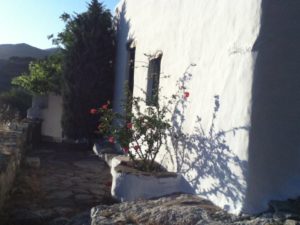
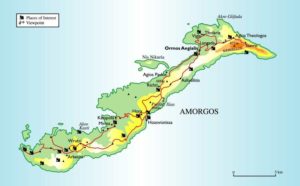
Constellations, the creative artistic festival on the island of Amorgos, is in its fourth year, organized by a group of 10 volunteers who live on Amorgos, two of them originally from the island. Amorgos is part of the Cyclades group of islands, its more famous islands are Mykenos, Santorini, Naxos, Paros and Syros.). It is less well known partly because it has no airport. You have to take a ferry there (8 hours from Athens, 3 hours from Naxos).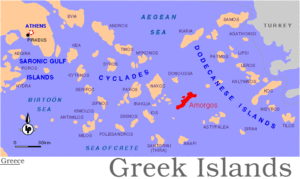
The festival celebrates the island and its amazing out of the way villages, churches, and landscapes. The island is rugged, formed of hard metamorphic and volcanic rock. It used to have forests and a lot more terraced hillsides. Today it has goats, donkeys, mules, olive trees, wild herbs (we always come back with oregano and sage,) and religious festivals. There are some beaches, great hiking, and good food. You can do yoga at Iris Studio by the beach, you can get acupuncutre and herbal tea from Vangelis in Langada, you can get a fantastic manicure from Elpida in Aigalis. But above all it is a beautiful friendly island with many amazing landscapes, houses, rustic churches and stunning villages without any cars. There is one road for cars from one end of the island to the other.
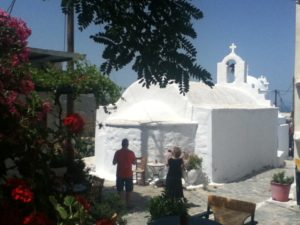
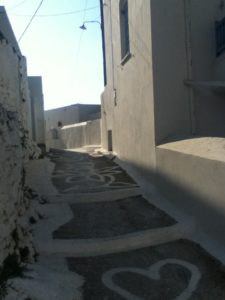
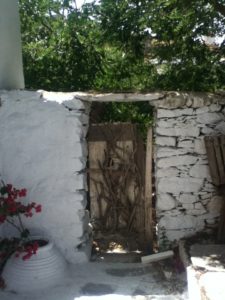
According to the organizers, the idea of the festival is to celebrate
“A diverse, beautiful place bursting with history and emotion.A circle of friends loving, and living on an Aegean island.This is Amorgos, and this is us. For the past three years talented artists from all over Greece have showcased their creative work, honoring us and our guests with their presence, and bringing life to the island. Our goal for the 4th year of the festival is to encourage more artists to participate.
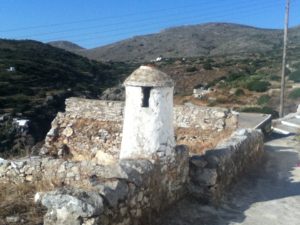
All performances take place next to ancient monuments, surrounded by landscapes of rare natural beauty without any complex stage settings.
No one involved in the organization of Asterismos (the Constellation), or any artists, is profiting financially in any way. Everything in this festival is created and offered out of love for the arts and the island.”
From Wednesday June 15 to Sunday July 3 they had events all over the island.
We saw three events while we were there.
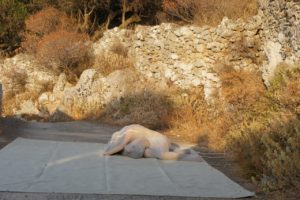
SaGyni Dance Theater by Fizz dance group took place in the last rays of the sun on a path to the famous Church of the Panagia Epanocholini. The path was just wide enough to provide a space for performing. The group began with a dance that for me evoked a connection to the most archaic kore and goddesses.
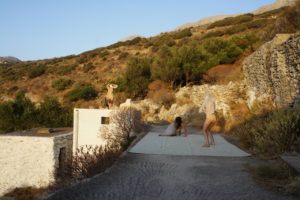
Amorgos is famous for the largest Cycladic figure ever found, which is now in the Archeological Museum in Athens. As these woman danced in their nude stocking costumes they appeared to be part of the earth, joined to a mythic past. They were like the Kore of the archaic era coming to life.
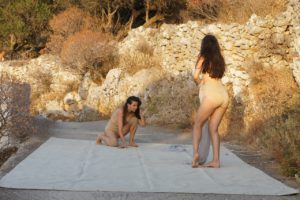
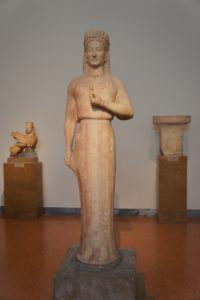
The stripping of that outer garment was clearly an act of liberation. The three dancers continued with several different dances and poetic recitals that evoked contemporary lives for women and feminist issues:
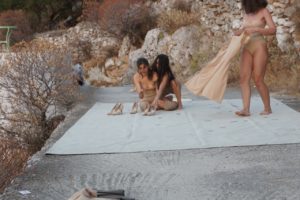
a scene of seduction between two women, a competition among the three women performed on chairs, signified by exchange of clothing, such as a jacket, a shirt and hat signifiying a man, reaching out and rejection, playing cards, high heel shoes, all of these performances and exchanges suggested emotional relationships. The three women are struggling to find a way. They were sometimes accompanied by recitations, but that was in Greek so I couldn’t understand the words, but the implication was musings and philosophical responses on the theme of women. The connection of the landscape and the dance/theater was perfect, they blended gently with the setting of the ancient stone walls, reddish bushes, and soft pink flowers, the setting sun, the cooling wind.
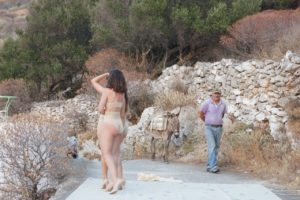
Then up the path came a man with his donkey! In Amorgos, donkeys are still very much the only transportation away from the single road. They are working donkeys that help to carry many things.
The Greek farmer leading the donkey could not pass, as we were seated on steps and blocked the road. He stayed and watched, although the donkey showed no interest and went to sleep.
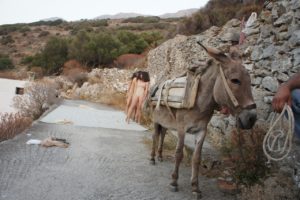
It was a thrilling partnership to the avant-garde artistic performance, two worlds, two lives, respecting each other, and part of the spirit of the Constellations festival on the island.
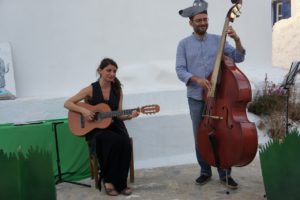
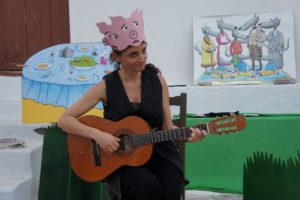
The next night we went to a performance for children called “Concerto for Double Bass and Wolves”
Dramatized narration by Mary Terzaki with Dimitris Sandalis on the bass cello.
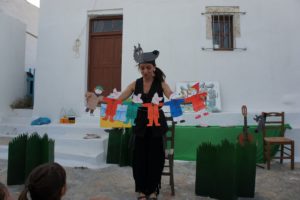
It was a retelling of fairy tales with wolves, recasting the wolf as a hero instead of as a scary character. At the end all of the children got up and danced along with Mary as they exchanged masks.
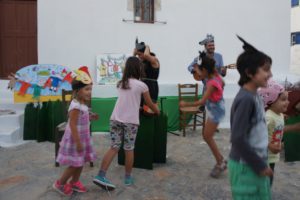
The last Constellation event that we went to was the theater performance “It’s been a year” by the Eos theater group from Athens.
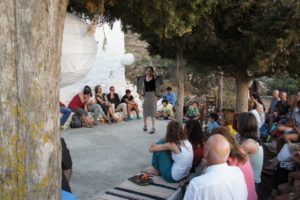
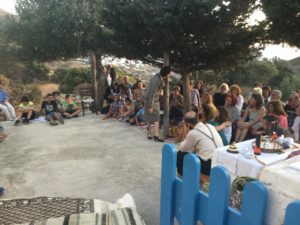
It was performed by seven actors at twilight on the top of a hill crowned by the famous Panagyia church of Amorgos.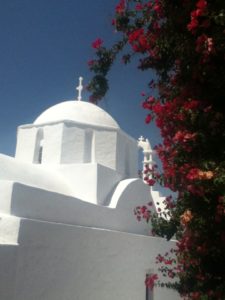 We see the playwright, Natalia Stulianou , below in the foreground, with her back to us.
We see the playwright, Natalia Stulianou , below in the foreground, with her back to us.
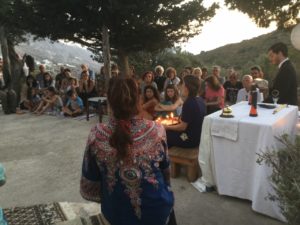
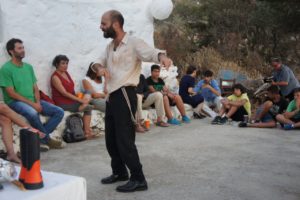
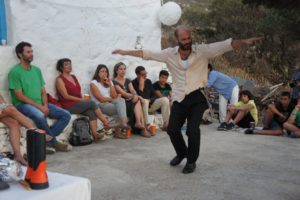
The acting was so good that I could sense what was happening even without understanding what they were saying. The story is told through the eyes of a young man, exploring his family home and thinking about his ancestors. You see him in the background in the blue shirt
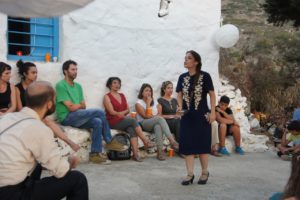
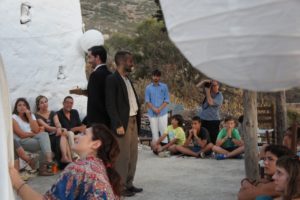
The Eos dance group is special. It emphasizes engagement with the audience. As they describe themselves “ EOS was founded in 2012 with the vision for an accessible expression and research in all forms of art, culture and social affairs. . . EOS runs several theatre training programs for young people, including programs for the training of young immigrant children . . .”
The full names of the cast in the play that we saw and the era that they represented is here:
One: Thalis Politis (First war 1914 – 1918)
Two: Semina Panigyropoulou (Second war 1939 – 1945)
Three: Dimitra Drakopoulou (Smyrna 1922)
Four: Iakovos Midrinos (the Civil War 1946 –1949)
Five: Angeliki Srati (the Dictatorship 1967 – 1974) –Natalia Stulanou, the playwright, was playing that part in Amorgos
Six: Dimitris Kakavoulas (the Economic Crisis starting in 1980 as a Greek broker in New York, who commits suicide)
Seven: Christos Dyonisopoulos (who lives today, brother of Six, and tries to find out about the lives of his ancestors, which are all the above)
I was so fortunate to be visiting my sister in law, who lives on the island of Amorgos, during this amazing festival.
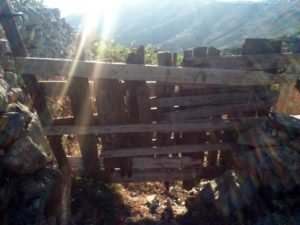
This entry was posted on July 31, 2016 and is filed under Amorgos Greece, Art and Activism, Art and Ecology, Art and Politics Now, art criticism, Uncategorized.








